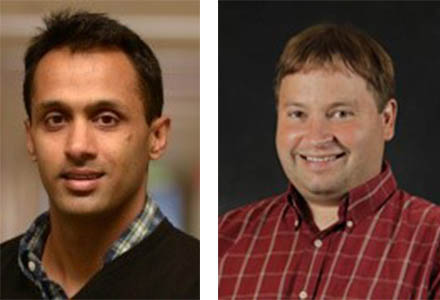Peptides developed which block entry of coronaviruses using host ACE2 receptors
Originally Published
 Dr. Amit Sharma, assistant professor, The Ohio State University College of Veterinary Medicine (pictured, left) and Dr. Ross Larue, assistant professor, The Ohio State University College of Pharmacy (pictured, right), are collaborating to develop, validate, and advance a family of small peptide inhibitors that block the interaction of SARS-CoV-2 Spike protein with ACE2 entry receptor. To invade the host cell, the SARS-CoV-2 Spike protein binds to the host cell ACE2 receptors, and this is followed by downstream events that allow the virus to fuse with the host cell membrane. Thus, by blocking the essential attachment of the virus to ACE2 using small peptide inhibitors, one could prevent SARS-CoV-2 entry and subsequent onset of COVID-19 in patients. This approach could offer great utility in reducing the infectivity of coronaviruses that utilize the ACE2 receptors to gain entry into hosts.
Dr. Amit Sharma, assistant professor, The Ohio State University College of Veterinary Medicine (pictured, left) and Dr. Ross Larue, assistant professor, The Ohio State University College of Pharmacy (pictured, right), are collaborating to develop, validate, and advance a family of small peptide inhibitors that block the interaction of SARS-CoV-2 Spike protein with ACE2 entry receptor. To invade the host cell, the SARS-CoV-2 Spike protein binds to the host cell ACE2 receptors, and this is followed by downstream events that allow the virus to fuse with the host cell membrane. Thus, by blocking the essential attachment of the virus to ACE2 using small peptide inhibitors, one could prevent SARS-CoV-2 entry and subsequent onset of COVID-19 in patients. This approach could offer great utility in reducing the infectivity of coronaviruses that utilize the ACE2 receptors to gain entry into hosts.
The Sharma/Larue approach resulted from fundamental structure-function analyses of the SARS-CoV-2 Spike receptor binding domains and then rationale design approaches to design peptide constructs capable of blocking the interaction of viral Spike protein with ACE2. The resultant peptides constructs were synthesized, and most importantly, the efficacy of viral blocking was assessed and validated in assays run for two human pathogenic coronaviruses that use the ACE2 as entry receptors: SARS-CoV-2 and HCoV-NL63. The technical details of this work have been submitted for publication and a patent application covering the validated constructs has been filed. Additional studies to advance this approach are underway.
Questions on collaborations with the Sharma/Larue laboratories or interest in licensing the peptide approaches should be directed to Dr. Jean Schelhorn (schelhorn.1@osu.edu or 614-638-9547) and Dr. Jay Dahlman (dahlman.3@osu.edu).